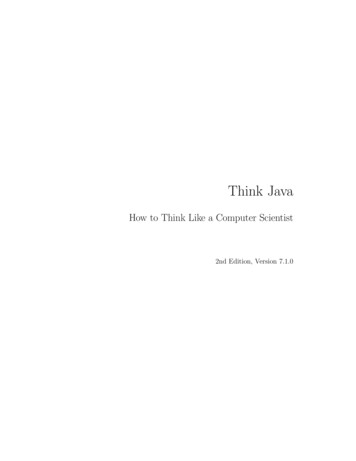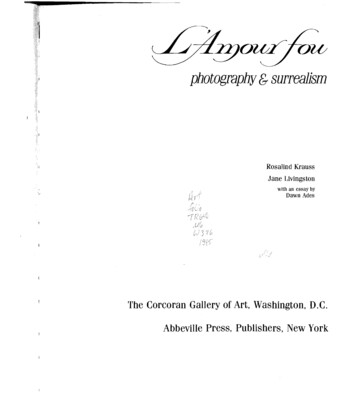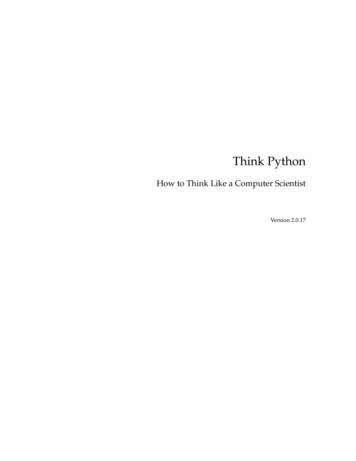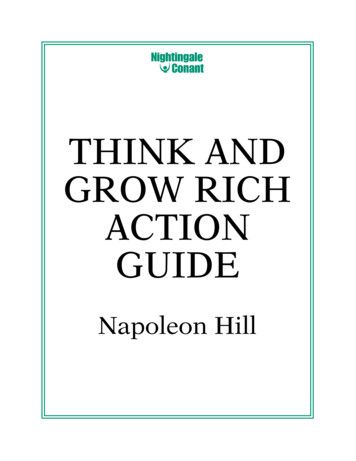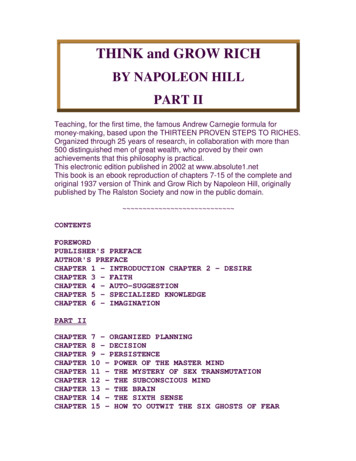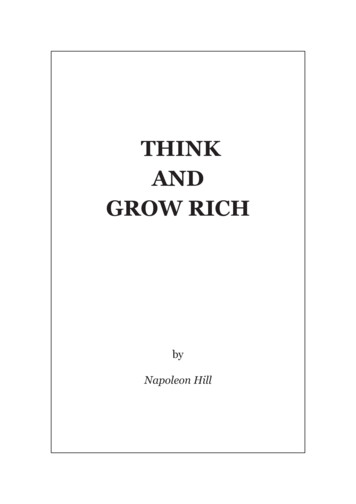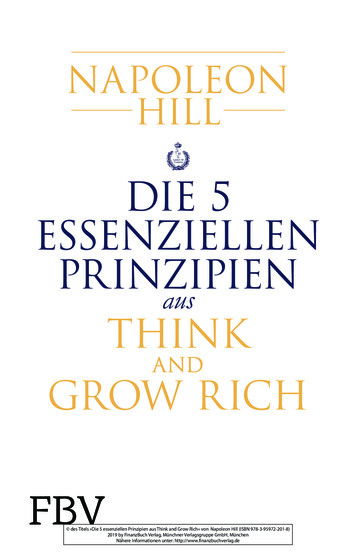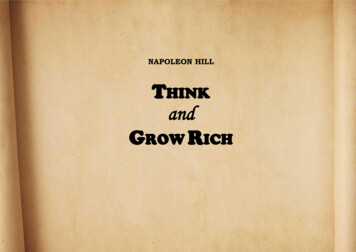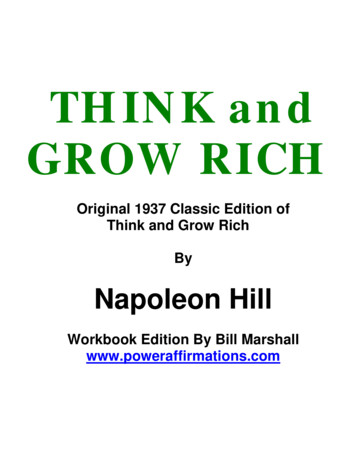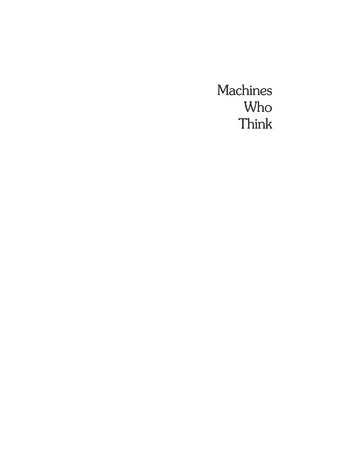
Transcription
MachinesWhoThinkFrontMatter.pmd11/30/2004, 12:15 PM
Other books by the author:Familiar Relations (novel)Working to the End (novel)The Fifth Generation (with Edward A. Feigenbaum)The Universal MachineThe Rise of the Expert Company(with Edward A. Feigenbaum and H. Penny Nii)Aaron’s CodeThe Futures of Women (with Nancy Ramsey)FrontMatter.pmd21/30/2004, 12:15 PM
MachinesWhoThinkA Personal Inquiry intothe History and Prospectsof Artificial Intelligence PamelaMcCorduckA K Peters, Ltd.Natick, MassachusettsFrontMatter.pmd31/30/2004, 12:15 PM
Editorial, Sales, and Customer Service OfficeA K Peters, Ltd.63 South AvenueNatick, MA 01760www.akpeters.comCopyright 2004 by A K Peters, Ltd.All rights reserved. No part of the material protected by this copyright noticemay be reproduced or utilized in any form, electronic or mechanical, includingphotocopying, recording, or by any information storage and retrieval system,without written permission from the copyright owner.“Artificial Intelligence”. Copyright (c) 1993, 1967, 1963 by Adrienne Rich,from COLLECTED EARLY POEMS: 1950-1970 by Adrienne Rich. Used bypermission of W. W. Norton & Company, Inc.Library of Congress Cataloging-in-Publication DataMcCorduck, Pamela, 1940Machines who think : a personal inquiry into the history and prospects ofartificial intelligence / Pamela McCorduck.–2nd ed.p. cm.Includes bibliographical references and index.ISBN 1-56881-205-11. Artificial intelligence–History. I. Title.Q335.M23 2003006.3’09–dc212003051791Printed in Canada08 07 06 05 04FrontMatter.pmd10 9 8 7 6 5 4 3 2 141/30/2004, 12:43 PM
To W.J.M., whose energetic curiositywas always a delightand, at the last, a wonder.FrontMatter.pmd51/30/2004, 12:15 PM
“Some of the people are saying the Eight Sages tookyou away to teach you magic,” said a little girlcousin. “They say they changed you into a bird, andyou flew to them.”“Some say you went to the city and became aprostitute,” another cousin giggled.“You might tell them that I met some teacherswho were willing to teach me science,” I said.The Woman Warrior: Memoirs of a Girlhood among Ghosts,—Maxine Hong Kingston“Everything should be made as simple as possible,but not simpler.”—Albert EinsteinFrontMatter.pmd61/30/2004, 12:15 PM
Contents Foreword xiPreface xviiTime Line: The Mechanization of Thinking xxiiiPart I Beginnings1 Brass for Brain 3Surveys attempts before the twentieth century to create artificial intelligences, bothliterary and real. Argues that twentieth-century artificial intelligence is only the latest,though the most successful, instance of a long Western tradition, and shares much withits ancestors.2 From Energy to Information 37Delineates the early attempts of philosophers, and later psychologists, to define themind, and the parallel attempts of mathematicians to turn human logic into rigorousmathematics. Shows that the dominant model for these thinkers was from physics, andthat not until cybernetics introduced a new model—information in an open system, asopposed to energy in a closed system—could the computer successfully be used as amedium for intelligent behavior.3 The Machinery of Wisdom 59Focuses on the computer as a medium for intelligent behavior, with close attention toAlan Turing, a brilliant British logician who helped design one of the first computersand was responsible for much early work in artificial intelligence. Discusses the American pioneer John von Neumann, who held a view opposite to Turing’s, that computerswould never be able to “think.”4 Meat Machines 85Traces the growing conviction that brains are a species of machine, the failed attempts toequate the on-off logic of the computer with the on-off logic of brain neurons. Reviewsthe early work of McCulloch and Pitts, as well as self-organizing systems, the Perceptron,and other attempts in the United States and Great Britain to link brains and machines.viiFrontMatter.pmd71/30/2004, 12:15 PM
viiiContentsPart II The Turning PointTururning5 The Dartmouth Conference 111Reports on a conference that in 1956 gathered the threads of an assortment of projects withthe same general underlying assumptions. Everyone was there, and the conference served asa rite of tribal identification that set patterns for future research and personal relations.6 The Information-Processing Model 137Covers the pioneering work of Newell, Shaw, and Simon, which set the tone for thenext decade of research. The influence of these men on computing and cognitivepsychology so pervades those fields that their discoveries and models are simply takenfor granted.7 Fun and Games 171Describes how computers were taught to play chess and checkers, and why this development made IBM so nervous. Analyzes the scientific and social significance of computer games.Part III Resistance8 Us and Them 195Discusses the critics of artificial intelligence, who give the lie to the idea that science isa disinterested enterprise. Includes some speculations as to why artificial intelligenceseems to provoke people to extremes, and covers the first extremist, Mortimer Taube,author of Computers and Common Sense.9 L’Affaire Dreyfus 211Considers the bitterest critic of artificial intelligence, who examined the evidence and foundit wanting. However, a computer walloped him at chess, and his demands continue to bemet. (Or do they?) Dreyfus and his book What Computers Can’t Do are introduced as fixturesin the artificial-intelligence community, and the man is presented as an example of thecommitted mind that finds only what it expects to find, even as scientists with the oppositecommitment find what they expect to find. Relates prophecies, insults, and other scientifichigh jinks—a case study in the subjective side of science and philosophy.Part IV Realizations10 Robotics and General Intelligence 243Investigates the robot and the difficulty of general, as opposed to special-purpose, intelligence. Presents two approaches, the General Problem Solver and the Advice Taker,and inspects some of the problems and solutions robot makers have encountered. Focuses on Shakey, the SRI robot, who rolled into the hearts and fears of millions—thanks to some scurrilous publicity.FrontMatter.pmd81/30/2004, 12:15 PM
Contents11 Language, Scenes, Symbols, and Understanding 277Views some of the interesting projects of the 1970s having to do with language, scenes,symbols, and understanding. Concentrates on language understanding, written andspoken, and parallel problems in visual analysis.12 Applied Artificial Intelligence 317Examines a here-and-now application of artificial intelligence in DENDRAL, the program that assists organic chemists, and some of its collateral programs. Looks at the MITeducation laboratory, which applies artificial-intelligence principles in a different way.Part V The Tensions of ChoiceTensions13 Can a Made-Up Mind Be Moral? 353Asks the questions: Can artificial intelligence really be created? If it can, should it?Reflects on the moral and ethical dimensions of artificial intelligence. ReviewsWeizenbaum’s Computer Power and Human Reason and responses to it.14 Forging the Gods 381Appraises the central scientific claim of artificial intelligence: that it demonstrates howsymbols can be embodied in a physical system, serving as a key to the understanding ofmind as the theory of evolution was to the understanding of biology. Regards artificialintelligence as a bridge between science and art, telling us about ourselves in somestartling ways. Speculates as to future directions.Part V Afterword:Afterword:The Following Quarter-Century of Artificial Intelligence 417The next quarter-century: from celebrity status to fragmented has-been, and back tosolid science; successful robots without symbolic intelligence raise big questions; skeptics continue to doubt and scientists continue to work at the job; achieving a major AIgoal-a machine beats the world’s chess champion-reveals new, more challenging goals;the growing realization that intelligence is both knowledge-based and collaborative;finally, the near future looks promising.Timeline: The Evolution of Intelligence 523Bibliography 535Index 547FrontMatter.pmd91/30/2004, 12:15 PMix
FrontMatter.pmd101/30/2004, 12:15 PM
Foreword Machines Who Think has its own modest history that may be worthtelling. In the early summer of 1974, John McCarthy made anemergency landing in his small plane in Alaska, at a place called(roughly translated) the Pass of Much Caribou Dung, so remote aspot he could not radio for help. Fortunately, John was rescued.It occurred to me then that before mortality claimed them, somebody ought to go around and ask these guys who’d begun thisodd field called artificial intelligence, what they thought they weredoing, and why.Eventually, I appointed myself. Later that summer, JohnMcCarthy, Ed Feigenbaum, and I had lunch at the Stanford Faculty Club, where I proposed my project. Ed, whom I’d approachedfirst, was enthusiastic, but John was less so. It was much too early,he said. There I’d be, waking up in five years and slapping myforehead: If only I’d waited for so-and-so to come on the scene! Ishould think about doing something else instead (and John had anumber of suggestions, most of them much too mathematical formy tastes). But when he saw I would not be deterred, he agreedto cooperate.My husband, Joseph Traub, and I returned from that summerstay at Stanford to Carnegie Mellon in Pittsburgh, where he wasthen head of the computer science department, and where thefaculty included Allen Newell, Herb Simon, and Raj Reddy. IxiFrontMatter.pmd111/30/2004, 12:15 PM
xiiMachines Who Thinkmade my proposal to each of them. They were encouraging, and allagreed to help—calling their colleagues elsewhere to introduce me,taking time out from extremely busy research lives to sit still forinterviews, and in Herb Simon’s case, opening his archives to me.Allen Newell in particular showed his good faith by arrangingfor some funding for travel and transcription of the interviewtapes I’d begun to make—money that long after publication Ilearned came from Ed Fredkin’s foundation. I owe both Newelland Fredkin deep and continuing thanks, and if these public thanksare belated, that doesn’t make them less heartfelt. The book wouldnot have seen the light of day without them.I’d certainly tried to find funding elsewhere. I approached anumber of foundations and government agencies, and nearly everyone agreed that this might be an interesting project, but I,alas, was merely a writer and not a trained historian of science.Sorry, no money was available to somebody who’d only publisheda couple of novels. I explained that while I lacked credentials as atrained historian of science, I hoped only to tell a story—this wassurely a science that had found its genesis in myth and legend,and might be something that would have an impact on everybody. Still no dice. One government agency, nameless out ofcourtesy, was explicit about its dedication to projects that married the humanities and the sciences, and so I presented myself tothem: a member of the faculty of a university English department, ready to tackle a science I thought was significant to anybody in the humanities. That agency couldn’t say no fast enough.Amazing, when you think about it. Here was a new science, itsfounding fathers all active, and surely prime material for historians ofscience at least. As I gathered material for my own story, I expectedto find those scholars in large numbers, seizing the opportunity tointerview what might possibly be the Leibnizes, the Newtons, theEinsteins of a new field. That prospect was fine by me; I was aimingto tell a story to people who didn’t normally read histories of science.But this isn’t how it turned out. Instead, I was alone. Thescientists I interviewed were delighted to help, and I could harvest their patient answers to my questions when those responsesFrontMatter.pmd121/30/2004, 12:15 PM
Forewordwere still fresh and spontaneous. Much, much later, when I askeda credentialed historian of science about this, she shook her head.“Nobody knew whether it would be important. Nobody wantedto take a chance.”If funders were reluctant, publishers were downright dismissive. As graduate students in Columbia’s School of the Arts, we’d allmemorized the depressing statistic that Joseph Heller’s classic, Catch22, had gone to 27 publishers before somebody took a chance onit. Machines Who Think was to go to something like 33. It was themid-1970s, and publishers returned the proposal with commentssuch as: “We’ve already done a book about computers.” Anotherfavorite: “Very interesting. Too bad it’s too late.”I, the author, lost heart. Doubts beset me. The rejectionswere painful, eventually too painful, to read. My husband offered to act as an intermediary, a shield—I let him. Gladly. Hewouldn’t let me quit. (“He never let me down,” I say in the original introduction to this book; we still laugh that it’s code for “Henever let up on me.”) Furthermore, though he was not a credentialed literary agent, he took matters into his own hands and soonfound Peter Renz, then at W. H. Freeman, the book-publishingarm of Scientific American, who took a chance on the project andon me. For Joe Traub, who has always been my greatest champion, even I’m at a loss for sufficient words of thanks.I knew when I finished Machines Who Think that for a while,I personally wanted to leave the general field of artificial intelligence to itself. Science moves in rhythms, in seasons, with periods of quiet, when knowledge is being assimilated, perhaps rearranged, possibly reassessed, and periods of great exuberance, whennew knowledge cascades in. We can’t always tell which is which.Technology changes, permitting the formerly infeasible, evenunthinkable. From the perspective of a few decades, cries of triumph and cries of disappointment sound different from how theysounded at the time. Other histories of the field came out, someadmirable, some not. I found other topics to write about.Then, a few years ago, Herb Simon emailed me a copy of anote he’d written to Ed Feigenbaum “I am repeatedly frustratedFrontMatter.pmd131/30/2004, 12:15 PMxiii
xivMachines Who Thinkby the kind of history of AI that continues to be transmittedthrough all kinds of channels, most of them thoroughly unreliable. I cite the [X] book as a case in point, but the history chapters or paragraphs in textbooks are only marginally better. Formy money, Machines Who Think continues to be the most reliable source on the first couple of decades. What are the chancesof getting it back into print ?”Soon, he emailed me directly: “Pamela: Do consider whatmight be done about bringing Machines Who Think back intoprint. More machines are thinking every day, and I would expectthat every one of them would want to buy a copy. Soccer robotsalone should account for a first printing.”Impossible to resist such flattery. So, 25 years later, I’ve goneback. The afterword that follows the original text of MachinesWho Think is a summary, not an exhaustive history, of the field’swork during this past quarter century, and it surely overlooks excellent accomplishments, particularly outside the United States.For this, I apologize in advance, and I hope some young writerwith the energy and Sitzfleisch I had 25 years ago is making herway through the international field of artificial intelligence, taperecorder (or whatever) in hand, evoking from the next generationwhy it does what it’s doing. My afterword is also much morepersonal, partly because I became a participant-observer in thesociology of artificial intelligence, and partly because—well, I’mnot a trained historian of science, you know.It’s unlikely I’ll write the history of the next 25 years in artificial intelligence research, but somebody—or even something—will. I look forward to reading that one.Let me thank those who gave me advice, pointers, and otherhelp this time around: first and foremost, my good friend EdFeigenbaum; then, Duane Adams, Danny Bobrow, BruceBuchanan, Bob Balzer, Ron Brachman, Harold Cohen, BobEisenstein, Jill Fineberg, Takeo Kanade, Sarah Keisler, and othermembers of the Nursebot Pearl research group; John Kender, Victor Lesser, Kathy McKeown, Tiger Merrin, Chuck Thorpe, andManuela Veloso. None of these generous people is responsible inFrontMatter.pmd141/30/2004, 12:15 PM
Forewordany way for my errors of commission, omission, or interpretation. How pleasant it would (and will) be to have an automatedpersonal assistant to blame!I owe thanks to my copy editor, Michelle Peters, whowas indefatigable in dotting my I’s and crossing my T’s, andto Darren Wotherspoon, who cast my words into invitingtypography. As this edition was in press, associate editor, KathrynWert struggled heroically but always with good humor to imposesome neatness on my scruffy ways. Above all, I’m grateful toAlice and Klaus Peters of A K Peters, Ltd., for bringing a newedition of Machines Who Think into print, and nurturing the transformation of what was promised as a brief afterword into anothernear-book.Pamela McCorduckSanta Fe, New MexicoNovember 2003FrontMatter.pmd151/30/2004, 12:15 PMxv
FrontMatter.pmd161/30/2004, 12:15 PM
Preface This book is a history of artificial intelligence, that audaciouseffort to duplicate in an artifact what we humans consider to beour most important, our identifying, property—our intelligence.In two senses, this history is a personal inquiry.First, I’ve not intended to be exhaustive. Instead, like theant in Herbert Simon’s Sciences of the Artificial, I’ve wanderedover the landscape where I would, dwelling on what fascinatedme and barely addressing what didn’t. Thus for example, thoughconsiderable work in artificial intelligence has been done in theorem proving, you’ll find little of it reported here. Neither mytraining nor my taste gives me appetite for this subject, and Irationalize such neglect by telling myself that theorems wouldonly scare away the nonspecialist reader this book is intendedfor. Another example: there’s a distinct American bias in myhistory, which may have been appropriate in earlier days, but isno longer. Vigorous research groups now exist in Europe, theSoviet Union, and Japan, and the British effort echoes throughout the history of artificial intelligence, sometimes merrily, sometimes sadly, but always a presence.On the other hand, my training and my taste have made meendlessly fascinated by the human personalities who figure in thishistory, and so they’ve received as much attention as their work.The history is personal in this sense too.xviiFrontMatter.pmd171/30/2004, 12:15 PM
xviiiMachines who thinkNow, this tendency toward personalities isn’t solely a matterof partiality. When young James Boswell, that biographer to whomEnglish letters owes so much, asked his hero, Dr. Samuel Johnson,how he came to create a monumental dictionary, Johnson put theyoung man off, saying that “it was not the effect of particularstudy; it had grown up in his mind insensibly.”But Boswell, nobody’s fool, wasn’t satisfied with that. An examination of the text of the dictionary would tell you some important things. For example, you could see that Johnson was acity man, who didn’t really know much about the sea or the countryside. He mixed up meanings of windward and leeward, andwhen a lady later asked him how it was possible he’d misdefinedpastern as the knee of a horse, Boswell reports that “instead ofmaking an elaborate defense, as she expected, Dr. Johnson at onceanswered ‘Ignorance, madam, pure ignorance.’”No, Boswell said, there’s more to a history than its texts. “Thereis,” he wrote, “perhaps in every thing of any consequence, a secrethistory which it would be amusing to know, could we have itauthentically communicated.”And so with artificial intelligence. Its texts tell us many thingsof consequence, and some references to those are in this book.From the texts we see that a
spoken, and parallel problems in visual analysis. 12 Applied Artificial Intelligence 317 Examines a here-and-now application of artificial intelligence in DENDRAL, the pro-gram that assists organic chemists, and some of its collateral programs. Looks at the MIT education laboratory, which applies art
